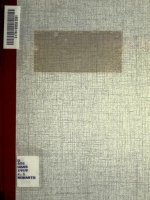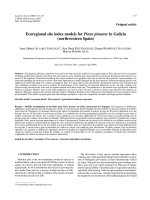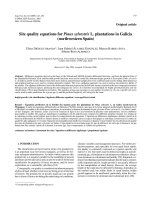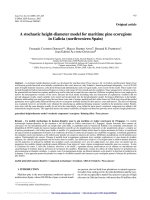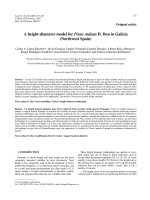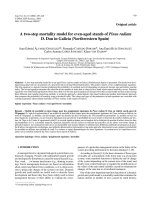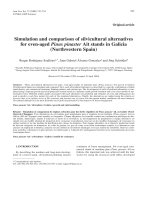galicia
Bạn đang xem bản rút gọn của tài liệu. Xem và tải ngay bản đầy đủ của tài liệu tại đây (33.05 KB, 3 trang )
Galicia Galicia is located in the green northwestern part of Spain. If
it was not for Santiago de Compestela, Galicia may not have been known
as well as it is. As it is some os Galicia's provinces are not even known to
tourists, and probably will never be. Unlike the rest of Spain, Galicia
looks much like Ireland. Which attracted the Celts during their
exploration. The landscape is lush and filled with pine and eucalyptus.
Galicia also has some of the best beaches in all of Spain. Gallegos
(Galicia's people) are very different from other Spanish people and seem
to almost be a different race. They have a whiter pailer complextion, and
have blond hair. They are also different in the things that they do for
entertainment. They don't have any of the high-tech theatures, or the
night life of Madrid. They are more interested in music, poetry, land,
family, witchcraft, death, and superstition. They spend a lot of time
thinking about things and why they are the way that they are. They
usually are not prejudice to any outsiders, and willing listen to their ideas.
People believe that many of these traits came from the Celts who came in
1000 B.C. and ruled until A.D. 137. They seem to have many things in
common with the Irish and the Scots because of this. Including a
bagpipe-like instrument called a Gaita. The language of Galicia is
different from the rest of Spain also, they speak a variation of Castillian
which has some French tones as well as Portuguese. They have their
own favorite foods also, which consist mainly of seafood. Some of their
specialty dishes are: merluza (hake), cigalas (prawns), camarones (small
shrimp). chipirones (little squid), langostines (crayfish), vieiras (scallops),
percebes (goose baracles), and trout and other local fish. Most of their
dishes are served either in casseroles or broiled, or steamed, or rolled
into crepes called empanadas. In the winter months, the dishes are
served with meat instead of seafood. Usually the meat is rabbit, or game.
Although ham, pork, and sausages are also served. Cheese is also
another specialty of Galicia, a entire meal can be made up of just cheese,
and not be boring! Many Gallegos have cheese and peasant bread for
their lunchtime meal every day. For desserts, the Gallegos make
excellant pastrys and sponge cakes, which are not found in any other part
of Spain. Wine is probably the greatest thing that Galicia has to offer
to the world, often said to be one of the best wine makers of the world.
Albarino is probably the best wine from Galicia, it is said to be Spains
long awaited white-wine. It is one of the most interesting wines in Spain,
and rapidly becoming one of the most expensive. The growing area for
Albarino is around the town of cambados, on the Atlantic coast in the
Pontevedra province. To be called Albarino, the wine must be made from
100% Albarino grapes. Albarino is a dry, elegant, acidy wine, and has a
very flowery smell. It is usually produced in small lot by Gallego artisans,
which causes it to be so expensive. Not long ago it was limited to Galicia,
but now a few businesses have begun to distribute it to other parts of
Spain. Galicia is also known for its religious festivals and every parish has
a festival for its patron saint once evey year. Since their are almost 4,000
parishes in Galicia you are very likely to be able to visit one when visiting.
During these festivals, you can purchase crafts, talk to neighbors, and
listen to live bands. Some of the more popular festivals are: Los Maios,
celebrated in May, and Magosto, celebrated in November. The
cathedral of Santiago is one of the major sites in Galicia, which is located
in the plaza de Obradoiro. It is a huge 17th century baroque cathedral
with two huge towers that seem to reach to heaven inself. In the
afternoon sun, the cathedral seems to glow a bright gold color whcih is
caused by a buildup of a lichen over the years. The churches
centerpiece is a statue of Saint Janes on top of the main altar at the front
of the central nave. At the back of the statue, there is a staircase that
leads up to the statue. Many pilgrims walk up the staircase to touch the
statue. Beneath the retable is a narrow passageway that leads to the
crypt which is built into the foundation of the 9th century church that used
to be there. The remains of the saint and his disciples are in silver
caskets there, and people go down to pay respect to him often. Back in
the main part of the the church, the high vaulted inside creates a
sensational feeling that is undescribable is felt. A gigantic censer hangs
in front of the altar, and on holidays it scents the entire church with
incense. The censer was built on such a large scale to try to cover up the
horrible smell of all the pilgrims after traveling to the cathedral. It is so
heavy that eight full grown men are required to swing it. The chapels
lining the walls of the church are filled with rich altars, tombs, and various
works of art. The reliquary chapel, located off the right name just inside
the cathedral contains valuable urns, and statues. The treasury contains
silver, gold, and brinze crucufixes from various centeries, statues of Saint
James, and jewelery. Upstairs, ther are Flemish tapestries from the 17th
century and a dozen from the 19th century based on the cartoons of
Goya. Finally after exiting the cathedral, you'll find many beautiful doors,
and archways. Be sure to see the Puerta de las Platerias, a romanesque
doorway, with carvings of king David and the creation of Adam and Eve.
The Hostal de los Reyes Catolicos is a finely hotel furnished that
would make excellant accomidations if funds allow. It is located right on
the Paza de Obradoiro, double rooms are currently around 32,000
pesetas a night during high season, and 25,000 pesetas off season,
which isn't too bad considering how expensive rooms in Paris and
London are. The lobby is filled with antiques as well as some of the
bedrooms. Paintings decerate the hallways and rooms, which have all
been recently refurbished. Many of the rooms have casement windows
that open onto a courtyard. The courtyards of Mark, Matthew, Luke and
John are a beautiful place to take a early morning walk. There are two
restaurants in the hotel, one casual, one more expensive and more
formal. The formal one has a mideivel look to it and has high vaulted
ceilings. The living room provides a wonderful place to wait for a seat in
one of the tow restaurants or a nice place to have an after dinner drink.
While there be sure to have the breakfast buffet. It includes dishes from
all over as well as local favorites. A good place to end the day is on the
stone bench that is in front of the Hotel, it provides a lovely view.
Shopping in the old town is also a good idea for spending a day. There is
no need to worry about getting lost and many international and local
crafts can be found all over the area. There is a large bookstore that
carries English-language books and newspapers which is a good place to
start off the shopping day. If you would like to spend a day at the beach,
the Isla De Arousa is an excellant island to spend it at. It is serviced by
frequent ferry service from Vilanova, and has many beautiful beaches
and also excellant sportfishing. It is the largest Island in Galicia and is
also the closest. Getting around Spain is fairly easy, the most
expensive, but easiest way is to rent a autoemobile, there is a good
network of roads going to every part of Spain starting at the Plaza Del Sol
in the center of Madrid, which is also the geographic center of Spain. If
you wish to save money the bus is also another good alternative, Spain
has a very good network of public bus systems that go almost anywhere
you would want to go. The train is also a very good way to travel.
Europe is famous for its train system and A person can get anywhere he
or she wants to go by train. Spains trains are fairly comfortable and travel
at reasonably fast speeds so you can get where you want to get quickly.

